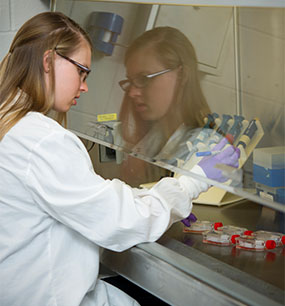Ocular herpesvirus infection

DVM, Ph.D.
Baker Institute for Animal Health
235 Hungerford Hill Road
Ithaca, NY 14853
Phone: (607) 256-5617
Fax: (607) 256-5608
grv23@cornell.edu
Developing a new model of ocular herpesvirus infection
Herpesvirus infection is an important cause of disease in dogs, cats, humans and many other animal species. Infection occurs via mucosal surfaces of the respiratory and genital tracts or via epithelial surfaces such as the cornea of the eye. Herpes simplex virus (HSV) -induced keratitis is the leading infectious cause of visual impairment and blindness in humans. Similarly, in companion animals, it is increasingly recognized that alphaherpesviruses are an important cause of ocular disease. Despite the clinical importance of herpesvirus-induced ocular disease, the underlying pathophysiology of this disease remains poorly understood, in part because of the lack of good in vitro models in which to study the cellular and viral factors involved in acute corneal infection.
Canine herpesvirus type 1 (CHV1) causes a variety of diseases in dogs including mortality in puppies and acute ocular disease in adult dogs. In order to be able to develop rationally based vaccines and novel antivirals for acute ocular herpesvirus infection in dogs, a comprehensive understanding of the pathogenic mechanisms and the viral factors involved during CHV1 infection in the eye is urgently needed. Such studies are hampered, however, as no in vitro models are available that would allow us to study viral replication and virus-host interaction of CHV1 in corneal epithelial cells or tissues. Therefore, we developed an air-liquid canine corneal organ culture system that supports CHV1 infection and serves as a valuable virus-natural host model system in which to study the pathogenesis of acute alphaherpesvirus-induced ocular disease.
Feline herpesvirus type 1 (FHV-1) is highly prevalent in cats, with up to 97% of cats being exposed to FHV-1 throughout their lifetime. This virus is not only the single most important pathogen in the US contributing to feline upper respiratory infection (URI), but it is also the most common viral pathogen to cause feline ocular disease. Based on our success in developing and validating a canine cornea organ culture system, we also developed a similar model to study FHV-1 in the eye and have used this to successfully evaluate the potential of novel antiviral drugs against FHV-1.
By developing novel tools for herpesvirus research and using those to study viral replication in a physiologically relevant and natural host model, we contend that we have a powerful tool to functionally unravel herpesvirus pathogenesis in the eye. As such, this will aid in achieving our long-term goal, namely to understand the mechanisms by which alphaherpesviruses induce acute ocular disease. We expect that such knowledge will be critical in the rational design of safer and more efficacious vaccines, and in the identification of antiviral drugs that can be safely applied to the corneal epithelium.





